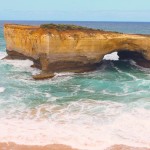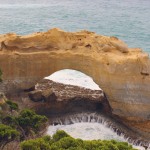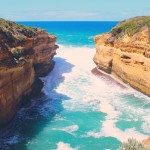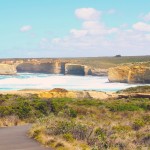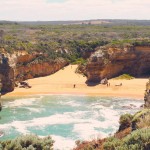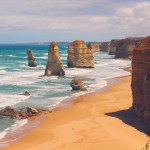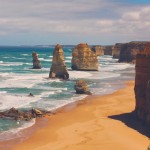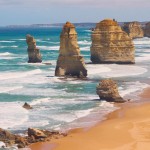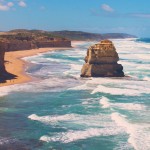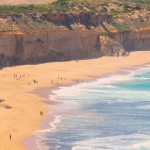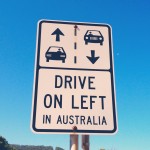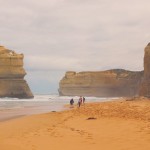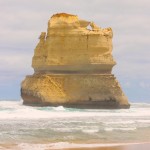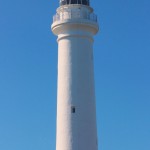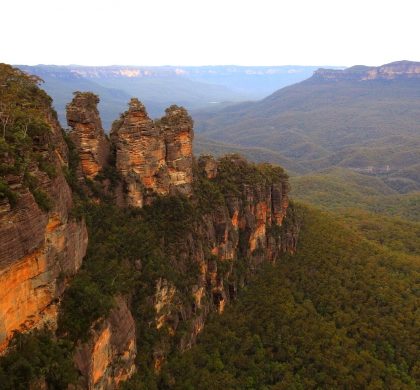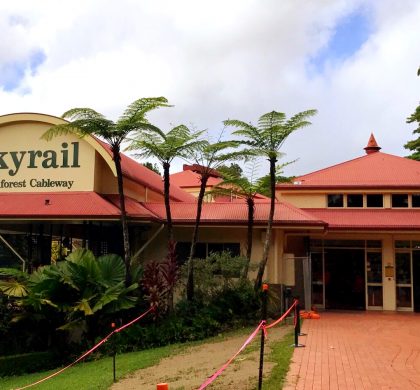It’s one of Australia’s greatest drives, if not one of the greatest in the world and the name says it all; the scenic Great Ocean Road. It begins in the costal own of Torquay, 20km south of the state of Victoria’s second largest city Geelong or about 95km south east from the capital city, Melbourne. The other end of this amazing stretch of road ends in the country Victorian town of Warrnambool which is over a three hour drive away from Melbourne non stop.
Today’s journey starts from Melbourne as we head down the Princes Freeway towards Geelong, however our Great Ocean Road journey will not begin at this end. We continue to drive on inland towards the other end of the Great Ocean Road, but not all the way to the end, we are aiming for the town of Port Campbell which is the closest town to the famous Twelve Apostles.
[wpgmza id=”91″]Port Campbell is a small town ideal for having a rest stop before checking out the natural sights of the Great Ocean Road after a long drive down from Melbourne. After having a rest we continue on a little further down the road for a couple of kilometres and arrived at the first attraction, London Bridge.
London Bridge was once connected to the mainland and walkers to the area were able to walk along the top of the two arches and stand out on what is now essentially an island. On 15 January 1990 two tourists were stranded out on that island when the arch connecting the London Bridge structure collapsed into the ocean below, they were subsequently rescued by helicopter a couple of hours later.
- Great Ocean Road, Australia
- Great Ocean Road, Australia
The collapse of the bridge demonstrates how fragile the area is, the rough and rugged Victorian Bass Strait coast is always changing and evolving and along this journey you will be able to see remnants of where the coast line used to be and of course where it now is.
The next stop along the way before going back through Port Campbell again is The Arch. This small stop along the way is kinda cool with the narrow rock protruding out from the side of the cliff in, you guessed it, an arch formation. If you’re lucky enough you might be able to get a few waves crashing through the centre of the arch.
- Great Ocean Road, Australia
- Great Ocean Road, Australia
One of my favourite locations along the Great Ocean Road is called Loch Ard Gorge and here you will find plenty of things to see and do in the area. There are two main car parks that allow you to walk from one to the other. Save yourself some time and drive from one to the other once you have finished checking out the sights on one side of the park.
When you enter you need to decide to go to the left or right car park, by going to the right first you can check out the Thunder Cave which is an impressive cave burrowing underneath the landscape. Walking down the path there is a lookout point where you can see the main entrance to the cave with the crashing of the white waves breaking as they go inside the cave.
- Great Ocean Road, Australia
- Great Ocean Road, Australia
Continuing down the path and you will come to a fork in the road, one way will continue down the hill towards Sherbrook River, down here you will have access to the beach and the river while getting up close to the massive cliffs that make us this pristine coast line. The other direction will take you out to the edge of a cliff to check out the view of the area. In the distance over the hill if you look hard you’ll be able to just make out the small point on top of one of the Twelve Apostles.
Walking back to the car park and heading over to the other side of the Loch Ard Gorge is where you’ll find my favourite spot of the whole area, the gorge itself. From the car park you have two vantage points close by to take in the scenery. You can then head down the path to the staircase which will take you down inside the gorge onto the sand where you will be greeted with a small cave by walking to the right, or head to the left to go down to the water’s edge.
- Great Ocean Road, Australia
- Great Ocean Road, Australia
Around the corner is another small cave which is worth going down to have a look at. The cave isn’t very big and you can’t go inside it but it’s quite cool looking at how the wind, sea and sand have slowly eaten away at this fragile landscape.
Heading back up the stairs there is another walk close to the car park that allows you to walk along the top length of the gorge that ends with a lookout. From here you gain impressive views looking back inside the gorge and also the island arch just to the corner of the gorge out in the ocean. There are also many other walks in the area of varying lengths, one of which can be accessed from both car parks that will take you to the Loch Ard Gorge Cemetery.
- Great Ocean Road, Australia
- Great Ocean Road, Australia
Leaving behind Loch Ard Gorge it is just a short drive down the road to the most famous part of the Victorian Shipwreck Coast, the Twelve Apostles are one of Victoria’s major tourist draw cards with people coming from all over the world to see these spectacular apostles. Twelve may have stood at one point, but with the changing landscape the apostles are becoming less and less as the years go on. The most recent collapsing was only a couple of years ago with the remnants of the rubble still seen today from the lookout.
The Twelve Apostles car park is on the opposite side of the road, you can then walk from here under the road to be taken to the main lookout which is usually crowded with anxious tourists vying for that perfect picture. The lookout is pretty long so there is plenty of room to get a prime position.
- Great Ocean Road, Australia
- Great Ocean Road, Australia
Continue along the board walked lookout and the path weaves its way around the cliff face to another lookout that gives impressive views of the other direction. One lone apostle lives out here and people are free to go down to the beach on this side to get up close. This is accessed by driving further down the Great Ocean Road and will be our next port of call.
After leaving the crowded Twelve Apostles lookout we headed to the next stop along the road, the Gibson Steps. The car parking here is pretty limited and you might spot people parking along the side of the Great Ocean Road itself and walking down from here. The steps are pretty steep and narrow so if you’re not comfortable with this type of thing this might not be a stop for you to make.
- Great Ocean Road, Australia
- Great Ocean Road, Australia
This is one of the more picturesque beaches you can gain access to with one of the giant apostles in the background so you can get up close and gain some perspective on how large they are, not only that but you can also see how tall the cliffs are that tower above the beach.
From the Gibson Steps it’s a long but scenic drive to Cape Otway. The main attraction here is the Cap Otway lighthouse which is located at the end of the road that turns off for the Otway region (called Otway lighthouse Road). But if lighthouses are not your type of thing never fear as there are an array of furry little friends waiting down this road, yes that sounds weird and a little disturbing but how else would you describe one of Australia’s animal icons, the Koala.
Driving down the Otway lighthouse Road you will soon start to notice that the road is lined with eucalyptus trees that are looking very bare with their white bark exposed. This usually means that Koalas have been present and have stripped the tree of all its leaves.
- Great Ocean Road, Australia
- Great Ocean Road, Australia
It is easy to spot Koalas while driving along, as many other people head down this road for the same reason. You will start to see other cars pulled up along the side of the road and people looking up into the trees to try and spot some of the fluffy animals usually sleeping the day away wedged between a fork in a tree.
If you’re lucky enough you shouldn’t have any trouble spotting more than one Koala, usually two or three will be based in any one location at a time, on this particular day there were quite a lot in multiple locations.
The Cape Otway Lighthouse however isn’t the most spectacular site, you have to pay an entry fee to even get up close to the lighthouse which frankly isn’t really worth the fuss. From here it’s best to start heading back along the main Great Ocean Road in the Melbourne direction heading through the main costal towns of Lorne, Apollo Bay and then Aireys Inlet.
At Aireys Inlet you will spot another lighthouse, the Split Point Lighthouse is best known to Australians as the filming location for the 90s children’s TV series Round The Twist. Unlike the Cape Otway Lighthouse you can actually walk right up to the base of this one and it’s worth it just to get out and stretch the legs. The lighthouse also runs tours so you can go inside and check out the inner workings of an operational lighthouse.
There you have it, without a doubt one of, if not the best costal drives in Australia. Many other costal drives rate very highly in Australia, however none are as nearly as iconic as the Great Ocean Road. You can easily set an entire day aside to explore the whole region and capture the main points along the road. The more ambitious traveller might want to make a whole weekend out of it and take a more steady pace.
One thing is for sure, no matter how you do it, this journey is a must for any visitor and you will not be disappointed by the ever changing scenery and the simply amazing landscapes that make up the Shipwreck Coast.
Recommended Posts
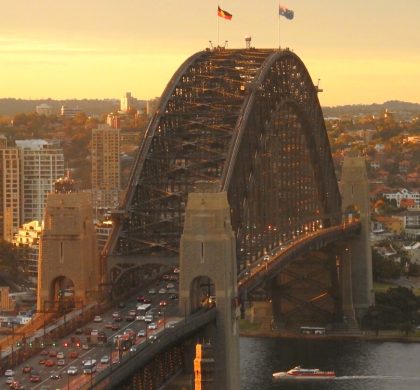
Hotel Review: Shangri-La Hotel Sydney & the best view in the world, Sydney, New South Wales
16 Jul 2017 - Hotel Review, New South Wales


